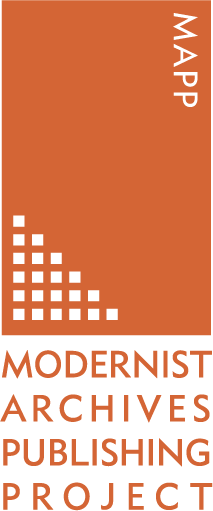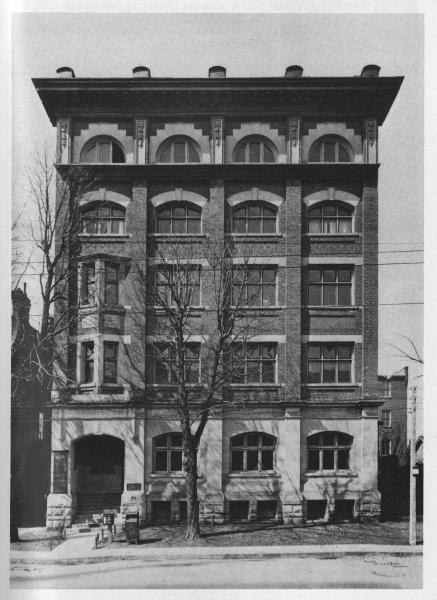Macmillan Company of Canada
Macmillan Company of Canada
Business Type:
Description
Authored By: Ruth Panofsky
By 26 December 1905, when Macmillan and Company opened a Toronto branch in the Clarendon building at 25–27 Richmond Street West – known among the trade as Booksellers Row – its imprint was highly respected worldwide, associated with the work of renowned British writers such as Matthew Arnold, Lewis Carroll, Thomas Hardy, Henry James, Rudyard Kipling, Christina Rossetti, Alfred Tennyson, and H.G. Wells. The Canadian branch, which shared premises with Oxford University Press Canada, was first an agency operation, mandated to market books published by Macmillan in London and New York. It also served as agent to several British firms whose books were distributed by the two houses of Macmillan. In fact, throughout its history the Macmillan Company of Canada (MCC) combined the roles of agency publisher, branch-plant, and original publisher in its operations.
MCC’s first president, Frank Wise, understood from the outset that his responsibility as publisher was to serve the interests of Canadian readers and national culture as much as it was to satisfy the agency needs of the parent company and its affiliate house in New York. With the assistance of editor John Cameron Saul, Wise used Macmillan’s name to build a strong educational division for the Canadian branch and encourage a fledgling literary culture for Canada through a publishing program that included works of history, fiction, and poetry that, in large part, was supported by profits from textbook sales.
By 1910, business had grown sufficiently to warrant construction of MCC’s own stately five-storey premises, with an above-ground basement, at 70 Bond Street in downtown Toronto. Designed by the architectural firm of Denison and Stephenson, the 27,000 square foot building was named St. Martin’s House after St. Martin’s Street in London, where the British company was housed.
In the first two decades of the company’s history, MCC’s literary aesthetic and culture, which endorsed serious, moral works over popular, ephemeral writing, were conceived and created as much by Wise as by the books he published. Wise’s strategic and vital role in advancing national literary culture, although preliminary, underscores the centrality of MCC’s early publishing program to Canada’s cultural enterprise.
In 1921, Hugh Eayrs succeeded Wise as president of MCC. At the time, Eayrs – not yet 26 – was an ambitious young man “who possessed great force of personality and an infectious sense of humour” (McKillop 185). He had been hired in 1916 to manage MCC’s educational department; by 1919 he had risen to company secretary and business manager. A visionary who believed along with George Platt Brett, president of Macmillan in New York, that a publishing house was “deeply and inescapably personal; [and] that only the devotion and individuality of its chiefs can make it or preserve it” (Brett qtd in Madison 264), the charismatic Eayrs consolidated MCC’s Canadian focus and heralded a new age in Canadian publishing.
Under Eayrs, MCC’s educational list expanded. He also used his prestige imprint to attract important authors, including best-selling novelist Mazo de la Roche, celebrated naturalist Grey Owl (the Native masquerade assumed by British-born Archibald Belaney), and popular humourist Stephen Leacock. Until his death in 1940, Eayrs pursued a vigorously diverse publishing program that featured fiction, poetry, and drama, folklore, history, and literary criticism.
Robert Huckvale, who was president from 1940 to 1946, oversaw MCC during the Second World War. However, without the aid of Gladys Neale, the accomplished head of MCC’s educational division, and Ellen Elliott, who had been secretary to Eayrs, Huckvale could not have managed the company. While Huckvale handled the firm’s finances, Elliott saw to its publishing programs. Officially, she was secretary and director of MCC; effectively, she functioned as “head of the publishing side of the business” (Gray 344).
The war years were difficult for Canadian publishers; they struggled with inadequate resources, economic instability, and national unrest. Until her departure from MCC in 1947, Elliott laboured tirelessly to sustain the company and build its roster of writers. Among the first executive women in Canadian publishing, she worked closely with many writers, among them novelists Irene Baird, Frederick Philip Grove, and W.O. Mitchell, and poets Audrey Alexandra Brown, P.K. Page, and E.J. Pratt.
Upon his return to Toronto from overseas service in 1946, John Gray was appointed general manager of MCC. Gray had worked as educational representative under Eayrs from 1930 to 1940. He was a bookman and a “natural publisher” (Gray 139) who shared Eayrs’s nationalistic pride in Canada. Temperamentally suited to the task of leader, he was named president in 1955 and “oversaw the most prosperous and successful period” (Whiteman xii-iii) in MCC’s history.
Gray’s “boisterous sense of fun” was balanced by his “executive abilities” and the “gift of subordinating his own ambition to the concerns of his writers” (Dickson 492). His first-hand knowledge of the arduous work that is writing – Gray received the University of British Columbia medal for his biography Lord Selkirk of Red River (1963) – may have resulted in the generous humility that characterized his relationships with authors and which earned him their respect. Until the company’s management structure changed in 1969, Gray was a leading publisher. With the assistance of editor Kildare Dobbs, he brought MCC to maturity as a flagship Canadian house.
From 1969 to 1976, Hugh Kane, first as president and later as vice-chairman of the board and director of its trade division, oversaw a publishing company with an enviable stable of writers. Editor Douglas Gibson joined Kane in 1974. He brought Alice Munro to MCC and issued her key early books, including Who Do You Think You Are? (1978). Gibson left MCC in 1986 to join McClelland & Stewart, while Munro, who went on to become one of the best literary authors Canada has ever produced, was awarded the Nobel Prize in Literature in 2013.
At the close of March 1973, Macmillan and Company sold its Canadian branch to Maclean Hunter. The new owner shifted MCC’s focus and literary titles gradually gave way to commercial books. By April 1980, when Gage Educational Publishing acquired the imprint, the Macmillan Company of Canada was in decline – after further transfer, it finally ceased to exist in 2002. For much of the twentieth century, however, MCC had been a prestige publisher of “trade books of high quality, which sell well and matter to Canada” (Amiel) and whose success was shaped by the vision and dedication of its skilled leaders. Its clearest triumph lay in its legacy of meticulously edited, tastefully designed books and the influence of enduring landmark works of fiction, such as Louis Hémon’s Maria Chapdelaine in English translation (1921; originally published in 1913); W.O. Mitchell’s Who Has Seen the Wind (1947), Ethel Wilson’s Swamp Angel (1955), Adele Wiseman’s The Sacrifice (1956), Hugh MacLennan’s The Watch That Ends the Night (1958), and Robertson Davies’s Fifth Business (1970). For 75 years, MCC had championed Canadian writers who, in turn, were proud to be associated with “the honesty and integrity which are synonymous with ‘Macmillan’” (Amiel).
The Macmillan Company of Canada’s success, when read against the international backdrop of historic, economic, and cultural upheavals of the twentieth century, attests to the sustained commitment of the parent company in London and the early support of the Macmillan Company of New York. More importantly, it exemplifies the drive and acumen of its presidents and editors – each of whom enriched the literary and cultural life of Canada – and the allegiance of award-winning writers – so many of whom went on to achieve acclaim – to a company that helped shape a culture of authorship for Canada.
Archives and papers
British Library, Manuscript Collections, Macmillan and Co. Ltd. records:
Add MSS 54786-56035, 61894-96, 89262, etc.
Library and Archives Canada, John Morgan Gray fonds:
http://data2.archives.ca/pdf/pdf001/p000002657.pdf
McMaster University Library, William Ready Division of Archives and Research Collections, Macmillan Company of Canada fonds:
http://archives.mcmaster.ca/index.php/macmillan-company-of-canada-fonds
New York Public Library, Manuscripts and Archives Division, Macmillan Company records:
http://archives.nypl.org/mss/1830
Thomas Fisher Rare Book Library, University of Toronto, Hugh Kane Papers
https://discoverarchives.library.utoronto.ca/index.php/hugh-kane-papers
University of Reading, Special Collections, Macmillan and Co. Ltd. records:
https://www/reading.ac.uk/special-collections/collections/sc-macmillan.aspx

